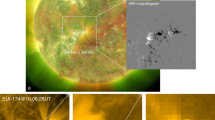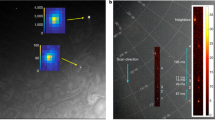Abstract
SUNSPOTS are areas of cooler gas and stronger magnetic fields in the Sun's photosphere (its 'surface'), but just how they form and are maintained has long been a puzzle. It has been proposed1 that small vertical magnetic flux tubes, generated deep within the Sun, develop downflows around them when they emerge at the surface. The downflows bring together a large number of flux tubes in a cluster to form a sunspot, which behaves as a single flux bundle as long as the downflows bind the flux tubes together. Until now, however, it has not been possible to test this model with subsurface observations. Here we use the recently developed technique of travel-time helioseismology2 to detect the presence of strong downflows beneath both sunspots and the bright features known as plages. The flows have a velocity of ∼2 kms-1, and they persist to a depth of about 2,000 km. The data suggest, however, that the vertical magnetic field can be a coherent flux bundle only to a depth of ∼600 km; below this depth it is possible that the downflows hold together a loose collection of flux tubes to maintain the sunspots that we see.
This is a preview of subscription content, access via your institution
Access options
Subscribe to this journal
Receive 51 print issues and online access
$199.00 per year
only $3.90 per issue
Buy this article
- Purchase on Springer Link
- Instant access to full article PDF
Prices may be subject to local taxes which are calculated during checkout
Similar content being viewed by others
References
Parker, E. N. Astrophys. J. 230, 905–913 (1979).
Duvall, T. L. Jr, Jefferies, S. M., Harvey, J. W. & Pomerantz, M. A. Nature 362, 430–432 (1993).
Lee, W. H. K. & Pereyra, V. in Seismic Tomography, Theory and Practice (eds Iyer, H. M. & Hirahara, K.) 9–22 (Chapman & Hall, New York, 1993).
Toner, C., Jefferies, S. M. & Duvall, T. L. Jr, Astrophys. J. (submitted).
Bracewell, R. N. The Fourier Transform and Its Applications 2nd edn (McGraw-Hill, New York, 1986).
Bahcall, J. N. & Ulrich, R. K. Rev. mod. Phys. 60, 297–372 (1988).
Woodard, M. F. & Libbrecht, K. G. Astrophys. J. 402, L77–L80 (1993).
Kuhn, J. R. & Libbrecht, K. G. Astrophys. J. 381, L35–L37 (1991).
Parker, E. N. Astrophys. J. 390, 290–296 (1992).
Author information
Authors and Affiliations
Rights and permissions
About this article
Cite this article
Duvall, T., D'Silva, S., Jefferies, S. et al. Downflows under sunspots detected by helioseismic tomography. Nature 379, 235–237 (1996). https://doi.org/10.1038/379235a0
Received:
Accepted:
Issue Date:
DOI: https://doi.org/10.1038/379235a0
This article is cited by
-
Eigen oscillations of facular knots
Astrophysics and Space Science (2019)
-
Comparison of Travel-Time and Amplitude Measurements for Deep-Focusing Time–Distance Helioseismology
Solar Physics (2018)
-
Local Helioseismology of Sunspots: Current Status and Perspectives
Solar Physics (2012)
-
Time–Distance Helioseismology Data-Analysis Pipeline for Helioseismic and Magnetic Imager Onboard Solar Dynamics Observatory (SDO/HMI) and Its Initial Results
Solar Physics (2012)
Comments
By submitting a comment you agree to abide by our Terms and Community Guidelines. If you find something abusive or that does not comply with our terms or guidelines please flag it as inappropriate.



